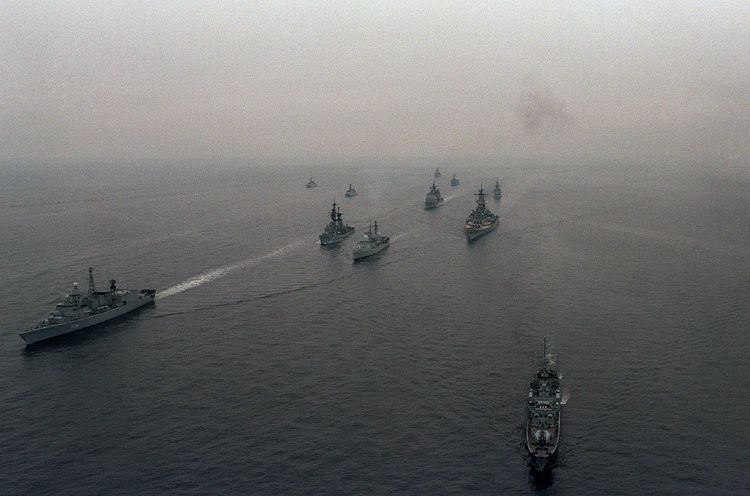 | ||
A Joint Task Force is a "joint" (multi-service) ad hoc military formation. The task force concept originated with the German Navy around the beginning of the Second World War in the Pacific.
Contents
- Numbered USMCEB joint task forces
- Named joint task forces
- United States Army and other non USMCEB task forces
- Others
- References
"Combined" is the British-American military term for multi-national formations.
There are two ways in which a U.S. or U.S.-allied task force may be assigned a number. The first is the originally naval scheme promulgated and governed by the U.S. Military Communications-Electronic Board, chaired by the Joint Staff J6. Task force numbers allocated under this scheme form the majority of the listings below.
The second is a by-product of the U.S. Army's procedure for forming task-organised forces for combat, differing from strictly doctrinally assigned table of organization and equipment organizations. A battalion, company or brigade commander has very wide latitude in selecting a task force name, though often the name of the commander is used (e.g. Task Force Faith; Task Force Smith was named for the commander of the 1st Battalion, 21st Infantry Regiment). This has often resulted in derivations from the originator unit's numerical designation being used. For example, when a special operations aviation unit was being formed in the late 1970s, the original unit drew heavily on personnel from the 158th Aviation. The designation chosen was Task Force 158, which later grew to become the 160th Special Operations Aviation Regiment. Another example comes from 2004 in Afghanistan. On 15 April 2004 the headquarters of the U.S. Army's 25th Infantry Division arrived in Afghanistan and took command of CJTF-180 from the 10th Mountain Division. Lieutenant General David Barno, commanding then decided to rename CJTF 180 because the “180” designation had traditionally been given to Joint task forces led by the Army's XVIII Airborne Corps. Barno chose Combined Joint Task Force 76 as the new name to evoke America’s history and the democratic spirit of 1776. The CFC-A commander intended this new designation to highlight the change in command at the operational level at a time when Afghanistan appeared to be moving closer to democracy.
No coordination appears to occur between U.S. Army task forces designated in this way, and the USMCEB scheme. This has resulted in simultaneous designations being used at the same time. For example, Combined Joint Task Force 76, was in use in Afghanistan in 2004, but doubling up on the Task Force 76 designation used for decades by Amphibious Force, United States Seventh Fleet, in north Asia.
Numbered USMCEB joint task forces
Allied Communications Publication 113: Call Signs Book for Ships in its Annex B lists allocations of task force numbers from 1 to approximately 1000, allocated by the United States Military Communications-Electronic Board in blocks for use by the United States Department of Defense and allies.
Norman Polmar notes in Ships and Aircraft of the U.S. Fleet, 2005, that the task forces under the commanders of the Atlantic and Pacific Fleet are mainly for contingency purposes. They are employed for specific operations and exercises.
Combined Task Force (CTF) 13 conducts a simulated long range raid on Camp Hanson, Okinawa Japan, March 21, 2016. CTF-13 conducted the raid, which commenced in South Korea, to demonstrate air assault, multi-continent long-range raid capabilities and the ability to deliver security and stability. CTF 13 included 1st Battalion, 3rd Marines.
Named joint task forces
Joint Task Force Shining Hope; Joint Task Force Eagle Vista (1998 Presidential African visit)
United States Army and other non-USMCEB task forces
These included Combined Joint Task Force 76, Combined Joint Task Force 82, and Combined Joint Task Force 180.
